

Fifteen ways to adapt your textbook so your students aren't bored to death. Unfortunately, teachers may only be given the textbook without any professional development or additional curriculum resources. It can be challenging, especially for newer teachers, to figure out how to use the textbook to meet the needs of culturally and linguistically diverse students who may be at different levels of English proficiency. It can also be difficult if the textbook is outdated or not well-designed in terms of instructional practice. Textbooks do have some advantages. They can provide a guide for effective language teaching, contain helpful models, save teachers time, and are usually leveled and aligned to standards. However, they can also present a danger when they are viewed (by teachers, administrators, or districts) as the “only” curriculum or one that must be followed precisely. In our experience, textbooks can be practical tools when used as a resource, not as a curriculum.
Adopting and Adapting Materials. Edutopia. Adaptation of Text for ELs. A checklist: Adapt, Incorporate, or Ditch a textbook activity? Love the textbook or hate it?
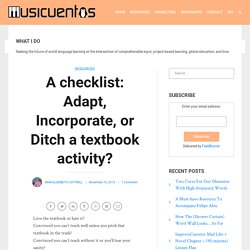
Convinced you can’t teach well unless you pitch that textbook in the trash? Convinced you can’t teach without it or you’ll lose your sanity? Wherever you fall, if a textbook is a tool in your classroom, this post is for you. Note that I believe a textbook is just that, a tool. It’s a tool like most others. Recently at the Texas Foreign Language Association I met with a small group of teachers for a 3-hour workshop called “Textbook as an AID: Adapt, Incorporate, Ditch.”
Many textbook activities could be useful in your classroom with your students with a few simple tweaks. I asked the teachers at my workshop to help me develop a checklist for you. Did you catch that part at the bottom?
20 Principles of language teaching. Content and Sequencing Format and Presentation Monitoring and Assessment Ongoing needs and environment analysis: The selection, ordering, presentation, and assessment of the material in a language course should be based on a continuing careful consideration of the learners and their needs, the teaching conditions, and the time and resources available.Feedback: Learners should reeive helpful feedback which will allow them to improve the quality of their language use.
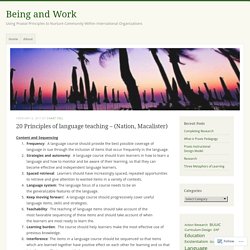
Like this: Like Loading... Writing Language Objectives. In this article written for Colorín Colorado, Jennifer Himmel of the Center for Applied Linguistics (CAL) provides an overview of how to use language objectives in content-area instruction for English learners.
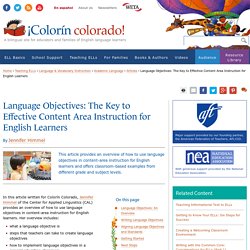
Her overview includes: what a language objective issteps that teachers can take to create language objectiveshow to implement language objectives in a general education classroomhow to align objectives to content and language standardsideas and resources on how to support teachers as they become familiar with this practice. Language Objectives: An Overview Mrs.
Shell has been teaching eighth grade math for twelve years. As Mrs. Academic English. Curriculum Approaches in Language Teaching. INTRODUCTION :- Approach is a way of dealing with something,a ways of doing something.
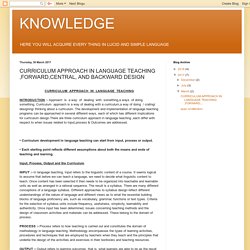
Curriculum approach is a way of dealing with a curriculum,a way of doing / crating/ designing/ thinking about a curriculum. The development and implementation of language teaching programs can be approached in several different ways, each of which has different implications for curriculum design.There are three curriculum approach in language teaching ,each differ with respect to when issues related to Input,process & Outcomes are addressed. • Curriculum development in language teaching can start from input, process or output. • Each starting point reflects different assumptions about both the means and ends of teaching and learning.
Input, Process, Output and the Curriculum INPUT :- In language teaching, Input refers to the linguistic content of a course. PROCESS :- Process refers to how teaching is carried out and constitutes the domain of methodology in language teaching. Language Curriculum Design Prezi. Curriculum Tools and Design. Language Curriculum Design Presentation. Quick Guide to Curriculum Design. Backward Design. How to Develop a Lesson Plan that Includes ELLs. In content-area courses, English language learners (ELLs) have a double challenge: they must learn language and content at the same time.
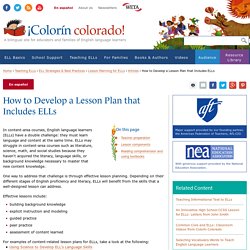
ELLs may struggle in content-area courses such as literature, science, math, and social studies because they haven't acquired the literacy, language skills, or background knowledge necessary to master that new content knowledge. One way to address that challenge is through effective lesson planning. Depending on their different stages of English proficiency and literacy, ELLs will benefit from the skills that a well-designed lesson can address. Effective lessons include: building background knowledgeexplicit instruction and modelingguided practicepeer practiceassessment of content learned For examples of content-related lesson plans for ELLs, take a look at the following: Teacher-student interactions, as well as peer interactions, are critical for learning.
Teacher preparation Once you get started, survey your target content to: Lesson components Writing 1. WIDA Lesson Plan Template. WIDA Lesson Plan. Lesson Planning for ESL/ELLs including the Cheatsheet - ELL ToolBox. Backward Design Lesson Plan. SIOP 4 Lesson Plan Templates. SIOP Lesson Plan Templates. Skip to main content You are not a member of this wiki.
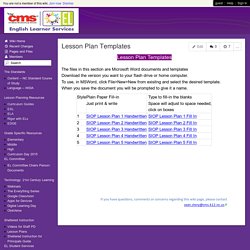
Join now Dismiss guest Help | Sign In Teachers of English Learners Home guest| Help | Sign In The Standards Lesson Planning Resources Grade Specific Resources EL Committee EL Committee Chairs Person: Documents Technology: 21st Century Learning Sheltered Instruction EL Student Services Teaching resources District-Supported Practices and Resources Professional Development for ELs Involving Parents Site Map Style GuideCMS EL departmentNCDPI ELD Wiki Turn off "Getting Started" SIOP activity interactive design template. SIOP Lesson Planning: Ingredients of Sheltered Instruction. Sheltered instruction is the practice of simultaneously: teaching content and cultivating language development. One framework that teachers can use to design sheltered instruction lessons is the Sheltered Instruction Observation Protocol (SIOP) created by Short, Vogt, and Echevarria more than 20 years ago. The SIOP Model is empirically-tested and research-based, which is why it’s used readily all over the world.